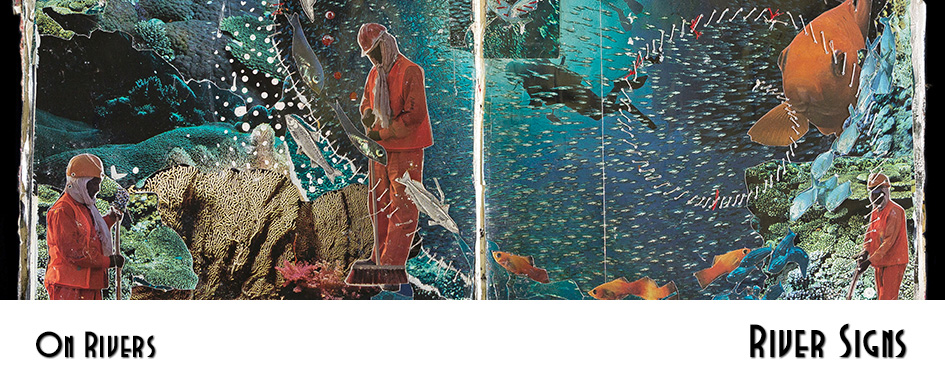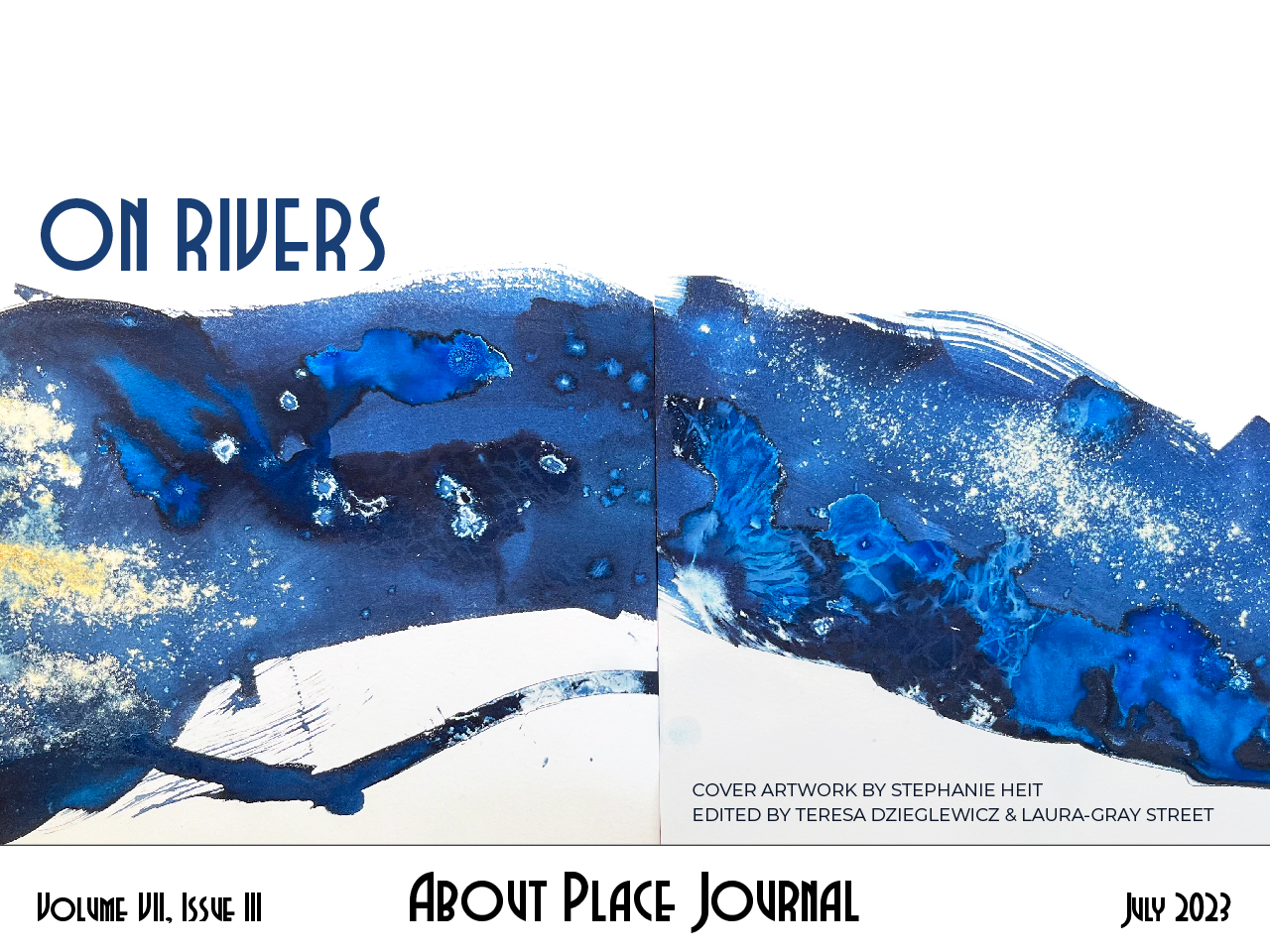Looking both ways
When I was a young woman, I lived on West 155th street in upper Manhattan. My tiny studio apartment looked out at the armpit of the building. But right across the street was what I called the Great River. Even then, decades before I learned the Lenape name, Muhheakantuck, it felt wrong to call such a beautiful body of water after an upstart European explorer. For an estimated 13,000 years, the river has flowed from Lake Tear of the Clouds in the Adirondack mountains, meeting the tides of the Atlantic Ocean about halfway on its journey to the New York Harbor.
I loved to walk north in Riverside Park to a particular spot: when I looked one way, I could see only the Palisades, no buildings, no cars, nothing but the cliffs. When I turned to look the other way, New York City spread out along the southern curve of the river, its port connected by the river and the Erie Canal to the Great Lakes. I never tired of marveling at that stark contrast and would take friends to stand there with me, looking right, then left, up, then down the great tidal river, the long arm of the sea. That contrast, and often conflict, between the inherent life of the river and human commerce and construct is ongoing.
East side, west side
Most of my life before and after my sojourn in Manhattan, I lived ninety miles north of the city in a region known as the Mid-Hudson Valley. When I was a child in eastern Dutchess County, the river was almost an hour’s drive away, crossed only on rare outings to see ancient maternal relatives on holiday at Mohonk Mountain House or to visit the Catskill Game Farm. We lived next door to an overgrown, abandoned estate once part of the Little Nine Partners land patent, the last of fourteen patents granted between 1685 and 1706, which once covered the entirety of historic Dutchess County, from the river to the Connecticut border. During the 1950s there were still many small, working farms, dairy and apple. Milk was delivered to the door in glass bottles, cream for coffee to be skimmed off the top.
As an adult, I lived in the central part of Dutchess County, twenty minutes drive from the former river estates of old families and robber barons, Roosevelt, Mills, Vanderbilt, all now state parks with walking trails open to the public. The Mills managed to keep the railroad tracks away from their riverfront, so I often walked the two miles of wooded trail between the rather hideous mansion and Norrie state park.
The west side of the river was where we went for more rigorous hiking a few times a year, all-day excursions with picnic lunches and changes of clothes. It was not till we moved to the Shawangunk Ridge ten years ago that we discovered Mohonk preserve, a not-for-profit, separate from the resort, and its more than eighty miles of trails that connect with Minnewaska State Park.
Unlike the agricultural eastern side of the river, the west side was once deforested for industry: mill stones, barrel staves, huckleberry barrens, quarrying, and the cement, mined in Rosendale, that built the pedestal of the Statue of Liberty among other national landmarks. I live near a former canal that carried coal from Pennsylvania to the river.
Those industries, like many of the small farms in Dutchess County, are gone now. IBM, once a major employer on both sides of the river, has been downsizing since the 1980s. Both sides of the river are now tourist destinations. There has been an influx of wealthy New Yorkers buying second homes, making it more difficult for fulltime residents to find affordable housing or rentals.
Though I grew up on the east side, I have fallen in love with west side, what I call the land of mountains and rivers. I don’t visit the Muhheakantuck as often as I did when I lived near the Mills estate, but I am very aware of the tributaries, the two nearby streams that flow from sky lakes to join the Rondout Creek, which merges with the Walkill Creek before they both flow into the Muhheakantuck. The Rondout Creek rises from a small stream in the Catskills. The health of these waters is critical to the health of the Great River.
Threats and Advocates
For approximately thirty years, starting in 1947, General Electric released more than a million pounds of PCBs into the upper Hudson River, eventually contaminating 200 miles of river and beyond into the harbor. Investigation of damage and cleanup efforts continue to the present, making the Hudson River and harbor the largest superfund site in the country.
The advocacy and educational work of the Sloop Clearwater (Clearwater.org) founded by Pete and Toshi Seeger in 1966, also continues. In addition to creating the public awareness and pressure that helped pass the 1972 Clean Water Act, Clearwater has been instrumental in bringing pressure to bear on GE to clean up PCBs as well as bringing attention to sewage and pesticide runoff, and the effects of hydrofracking.
Built in the 1950s and 60s (on a fault line!), the now decommissioned Indian Point Nuclear Power Plant continues to be controversial. Holtec International, administrator of the site now known as Indian Point Energy Center, has announced plans to begin discharging radioactive water into the river in August 2023, perhaps earlier. Riverkeeper.org is rallying support for a bill that would halt discharge of radioactive waste in waters across the state. Riverkeeper also advocates for alternatives to proposed storm barriers that could choke off the river’s aquatic life.
Scenic Hudson is another advocacy organization. In addition to preserving land and creating parks, Scenic Hudson joined with other organizations to prevent the lower Hudson from becoming a parking lot for oil barges carrying Bakken crude bound for export. A spill of crude oil in the tidal Hudson would devastate aquatic life and contaminate the drinking water for river towns. In 2021 oil barge anchorages in the lower Hudson River were federally banned.
The above is an incomplete sketch of the ongoing threats to the health of the river and of the tireless work of organizations and citizens who never stop advocating for the water that is the life of this region. It is noteworthy that all three of these organizations invite people into relationship with the river and each other. Sloop Clearwater is a floating classroom and the focus of a community that hosts the annual Great Hudson River Revival, an art and music festival that promotes environmental action and social justice.
Riverkeeper trains citizen scientists to help test the water quality of all the Hudson River’s tributaries. Every May, Riverkeeper hosts an event called Riversweep, enlisting volunteers from the New York, New Jersey shore, all the way up the river and its creeks, to remove everything from plastic bottles and discarded tires to abandoned boats. I join others at my local creek, the Rondout, crawling over rocks and brambles to comb the floodplain for debris. It is inspiring to be part of an effort that spans the entire river valley and harbor.
Scenic Hudson also hosts events and welcomes the involvement of volunteers and activists. I confess my direct knowledge of Scenic Hudson’s work is gratefully walking the miles of riverfront the organization has preserved, forests and wetlands, rocky outcroppings and vernal pools, and all manner of habitat for the diverse life of the river.
Riverside hermit
From 1997 until they sold the land to Scenic Hudson in 2015, I made annual hermitage retreats at Villa Saint Dominic, run by the Sisters of Corazon on the river’s west side in Glasco, New York. At a discreet distance from the rambling main house, where the sisters hosted group retreats, two self-contained cottages for hermits perched on a bluff overlooking the river.
Every dawn I would go sit on the porch with coffee to watch the sunrise, how the birds responded to each increment of light and shift in air. Then I would walk through the woods, past the waterfall flowing to meet the river, to one of those rocky beaches cradled by the tidal roots of trees. Villa St Dominic preserved and maintained a mile of riverfront trail that climbed up and down bluffs to Villa St Joseph at the other end of the property where another waterfall met the river. Along this shore I got to know the river tides, six feet of difference between high and low. At low tide I walked right next to the water. I could tell the direction of the tide by sticks that floated with or against the current.
During summer retreats, I swam in the buoyant water that always carried a whiff of the sea. I got to know many of the river trees. An oak with six arcing trunks provided a nest where I could lie right over the water. One autumn six swans flew above the tree, so low I could hear their wing beats. I walked the trails by the river in all lights and seasons, all weathers. On one late winter/early spring retreat, I heard the ice break up, the crash and groan of the heaves, the high notes of thin ice shattering the edge of the shore. Once I walked in fog so thick I could not see anything but the hairline crack in my cornea. On warm summer dusks, I would go down to the shore to watch the sturgeon leap from the water high into the air, landing with an impressive splash. I also came within a few feet of a bald eagle.
Although I’ve spent most of my life in the Mid-Hudson Valley, on both the east and west sides of the Muhheakantuck, except for my sojourn on 155th Street, I’ve never lived next to the river. On hermitage retreats, I entered into a more intimate relationship the Muhheakantuck as a living being, a mysterious, multi-faceted life that is whole-in-itself.
Time is a tidal river
There is a current movement (pun perhaps intended), often led by indigenous peoples, to recognize rivers as persons with legal rights, for example the right to flow, the right to be free from pollution, the right to biodiversity. And if these rights are violated, the river can go to court. It could be that given the imperfection of human legal systems, more complications will ensue. But it seems to me an important shift in perception: there are other beings besides human, including fluvial, arboreal, geological and more, who are persons as well as places with their own integrity, their right to exist.
It was European settlers who viewed the streams, rivers, and mountains of the Hudson River Valley as sources of wealth and gain. They displaced and made war on the Lenape and other tribes, some of whose descendants now live in Oklahoma, Wisconsin, and Ontario. But for thousands of years indigenous peoples have lived in the valley of the Muhheakantuck, farming and fishing on the river banks in the summer and hunting in the mountains in the winter.
My martial arts teacher was born near Indian Point. His family moved to the west side of the river where he spent much of his childhood. One day he took us to a park by the river. He told us to spread out on our own and find a place to stand or sit, to open our minds and senses to the life of the people who were here before the land and the river was taken over by Europeans. Here is a fragment of what came to me, at best a loose translation of what may be only my own imagination: Time is a tidal river; you can travel either way.


